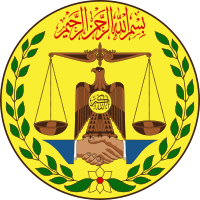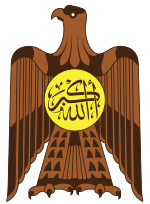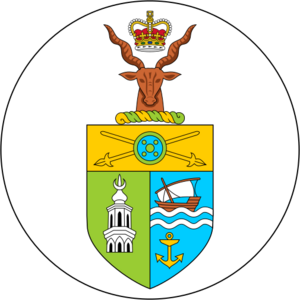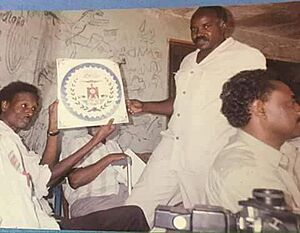National emblem of Somaliland facts for kids
Quick facts for kids National Emblem of Somaliland |
|
|---|---|
 |
|
| Versions | |

Eagle of Emblem of Somaliland
|
|
| Armiger | Republic of Somaliland |
| Adopted | October 14, 1996 |
| Crest | Bismillah |
The national emblem of Somaliland is a special symbol for the country. It was first used on October 14, 1996. This happened at the same time as the flag of Somaliland was approved. A person named Abdullahi Abdi Omar (Jawaan) helped create it.
Somaliland declared itself independent on May 18, 1991. However, most countries and international groups do not officially recognize Somaliland as an independent country.
Contents
What the Somaliland Emblem Means
The emblem of Somaliland has many important symbols. Each part tells a story about the country and its people.
- Scales: These are balanced and show that there is justice for everyone in Somaliland.
- Eagle: A brown-colored eagle of Saladin holds the scales. The eagle stands for democracy, meaning people have a say in their government.
- Shaking Hands: Two hands shaking represent equality and freedom for all people in Somaliland.
- Olive Branch: An olive branch is a symbol of peace among the people of Somaliland.
- Yellow Background: The bright yellow color behind the symbols shows the beautiful culture and people of Somaliland.
- Islamic Words: Above the scales, there is Islamic calligraphy. It says Bismillah, which means "In the name of Allah, Most Gracious, Most Merciful" in English. This shows that Islam is the main religion in Somaliland.
The Constitution of Somaliland is the country's main law. It was approved in 2001. It talks about the emblem in Article 7. It describes the falcon (eagle), the shaking hands, and the scales. It also mentions the green leaves and the Bismillah at the top.
- Over time, some small changes were made to the emblem. The words "Allahu Akbar" were removed from the eagle's chest. Also, the color of the Bismillah changed from brown to red.
Old Emblems of British Somaliland
Before Somaliland became independent, it was a territory controlled by the British. This area was known as British Somaliland.
Early British Somaliland Emblem (1903-1950)

In 1903, the British took control of the area that is now Somaliland. They made it a "protectorate," which means they protected and governed it. The British created a flag and an emblem for this new territory. The first emblem was a white circle with a picture of a Kudu. A Kudu is a type of antelope that lives in Somaliland. This emblem was also shown on the flag.
Later British Somaliland Emblem (1950-1960)

In 1950, the emblem of British Somaliland was changed. The new emblem was more detailed. It had a shield divided into green and blue parts. At the top of the shield, there was a Somali shield with two spears crossed behind it.
The green part of the shield showed a white minaret, which is a tower from a mosque. The blue part had an Arabian dhow, which is a type of boat, sailing on waves. There was also a golden anchor at the bottom. Above the shield, there was a Kudu's head with a crown between its horns.
British Somaliland became independent on June 26, 1960. It was then called the State of Somaliland. A few days later, on July 1, 1960, it joined with another area called Italian Somaliland. Together, they formed the Somali Republic.
See also
 In Spanish: Emblema nacional de Somalilandia para niños
In Spanish: Emblema nacional de Somalilandia para niños


